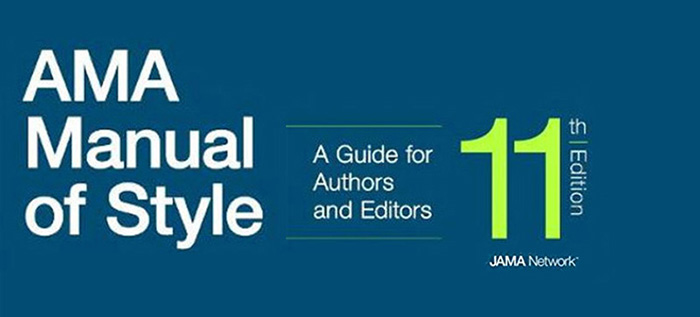VCU Libraries offers essential AMA style guide online
March 11, 2020
VCU Libraries now offers an online version of the newest edition of the The AMA Manual of Style. This is a must-use guide for those seeking to publish research findings in the health and biomedical sciences fields.
In addition to nuts-and-bolts guidance on punctuation, capitalization and grammar, the new online edition covers how to cite social media, preprints, data, podcasts, and other resources. It provides regular updates on timely topics, such as appropriate nomenclature for COVID-19. It also includes recommendations on how to navigate the dilemmas that authors, researchers and their institutions, medical editors and publishers, writers and members of the news media who cover scientific research confront.
Written by an expert committee of JAMA Network editors, this 11th edition thoroughly covers ethical and legal issues, authorship, conflicts of interest, scientific misconduct, and intellectual property, as well as preparation of articles for publication, style, terminology, measurement, and quantification.
“We expect this resource will be of great use to those in the VCU community who are writing on health sciences topics,” said Karen Gau, collection librarian for Tompkins-McCaw Library for the Health Sciences.
The manual was published online in February 2020 by Oxford University Press.
The history of the manual
< Previous Next >According to the website, "the first edition of an editorial manual for the AMA’s scientific journals appeared in October 1962; it was 68 pages long and was intended primarily as a guide for in-house staff and, secondarily, for authors. It grew slowly but surely: from 90 pages in the second edition, published in 1963, to more than 154 pages in the sixth edition, published in 1976. These editions were all published by the AMA and continued to be intended primarily for use by the in-house scientific publications staff, although recognition was growing that authors, as well as editors at other publishers, were using the book as a reference. With the seventh edition, published in 1981 and weighing in at 183 pages, this larger audience was recognized by a change in the book’s title to Manual for Authors & Editors and, for the first time, the book was published by an outside publisher (Lange Medical Publications).
With the eighth edition began the current approach of having a committee of 10 professional editors from the staff of JAMA and the Archives Journals responsible for the content, obtaining external peer review on all sections. This edition, published as a hardcover book in 1989 by Williams & Wilkins, was 377 pages. The growth in the audience is represented by sales of more than 33,000 copies. The single greatest area of expansion in the eighth edition was nomenclature: coverage grew from about 11 pages in the seventh edition to 54 pages. Glossaries of printing and production terms, as well as a resource bibliography, were added. The ninth edition, published by Lippincott Williams & Wilkins in 1998, saw an even greater expansion in pages and sales: 660 pages and more than 44,000 copies. In this edition, the coverage of nomenclature continued to expand (up to 130 pages), but the largest new areas of expansion were in statistics (from 5 to 60 pages) and ethical and legal considerations (from 9 to 85 pages).
In the 10th edition, published in 2007 by Oxford University Press, the book grew substantially, totaling 1032 pages. A chapter on medical indexes was added. The Legal and Ethical Considerations chapter expanded again, from 85 pages to 175 pages; Nomenclature also continued to expand, from 130 to 247 pages. With the split of the chapter on manuscript preparation into 3 chapters, there was greater coverage of references (eg, from 15 to 50 examples of electronic reference citation) and visual presentation of data. Throughout the book, there was an increased international scope and recognition of the changes in the scientific publishing field associated with advances in technology, the internet, and the electronic evolution of writing, editing, and publishing. The index is more detailed (expanded from 19 to 33 pages) and the more detailed running heads were intended to make the book easier to use.
Now in its 11th edition, the AMA Manual of Style has continued to evolve and expand, now up to nearly 1200 pages. The approach was the same: a committee of 10 JAMA Network editorial staff met regularly, researched, wrote, revised, responded to peer reviewers (thanked at the end of individual chapters and in the Acknowledgments), and revised some more. The entire process from first meeting to last galley proof took about 5 years. The 11th edition contains 2 fewer chapters (from 25 in the 10th to 23 in the 11th). After much consideration, the chapter on indexing was removed, owing to the fact that online searching has become fairly sophisticated. We also have combined the chapters on typography and manuscript editing and proofreading into one addressing the technical and aesthetic aspects of editing and publication display.
The organization of the manual has been revised. The five “sections” from the 10th edition are no longer; however, the 23 chapters are presented in the same order as in the 10th to provide continuity to long-time users. Content is organized in deeper “chunks” to enable precise location of information for references and in searches, with numerous numbered cross-referenced and linked subsections to the x.x.x.x.x level. Each chapter has been extensively revised and updated to reflect best practices and developments in scientific research, writing, and publishing, with numerous new examples, updated references, and for the first time, full-color graphics."
 Chat
Chat